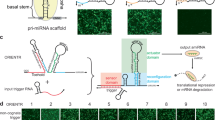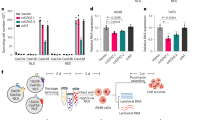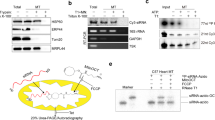Abstract
Use of RNA interference (RNAi) as a reverse genetics tool for silencing genes in mammalian cells is achieved by in vitro transfection of small interfering RNAs (siRNAs). For a target gene, several siRNAs must be designed according to the empirical rules. We demonstrated that functional short hairpin RNAs (shRNAs) could be synthesized in Escherichia coli and delivered directly via bacterial invasion to the near entirety of a mammalian cell population to trigger RNAi. Furthermore, using a luciferase–target gene transcript, we identified effective shRNAs and siRNAs from RNAi libraries delivered conveniently through bacterial invasion in 96-well plates without need for preparation, purification and transfection of shRNAs. Notably, several of the most highly effective shRNAs and siRNAs identified do not fit the empirical rules commonly used for siRNA design, suggesting that this approach is a powerful tool for RNAi research, and could be used complementarily to the empirical rules for RNAi applications.
This is a preview of subscription content, access via your institution
Access options
Subscribe to this journal
Receive 12 print issues and online access
$259.00 per year
only $21.58 per issue
Buy this article
- Purchase on SpringerLink
- Instant access to full article PDF
Prices may be subject to local taxes which are calculated during checkout





Similar content being viewed by others
References
Elbashir, S.M. et al. Duplexes of 21-nucleotide RNAs mediate RNA interference in cultured mammalian cells. Nature 411, 494–498 (2001).
Yu, J.Y., DeRuiter, S.L. & Turner, D.L. RNA interference by expression of short-interfering RNAs and hairpin RNAs in mammalian cells. Proc. Natl. Acad. Sci. USA 99, 6047–6053 (2002).
Khvorova, A., Reynolds, A. & Jayasena, S.D. Functional siRNAs and miRNAs exhibit strand bias. Cell 115, 209–216 (2003).
Schwarz, D.S. et al. Asymmetry in the assembly of the RNAi enzyme complex. Cell 115, 199–208 (2003).
Reynolds, A. et al. Rational siRNA design for RNA interference. Nat. Biotechnol. 22, 326–330 (2004).
Sohail, M., Doran, G., Riedemann, J., Macaulay, V. & Southern, E.M. A simple and cost-effective method for producing small interfering RNAs with high efficacy. Nucleic Acids Res. 31, e38 (2003).
Donze, O. & Picard, D. RNA interference in mammalian cells using siRNAs synthesized with T7 RNA polymerase. Nucleic Acids Res. 30, e46 (2002).
Grillot-Courvalin, C. et al. Functional gene transfer from intracellular bacteria to mammalian cells. Nat. Biotechnol. 16, 862–866 (1998).
Fajac, I. et al. Recombinant Escherichia coli as a gene delivery vector into airway epithelial cells. J. Control. Release 97, 371–381 (2004).
Critchley, R.J. et al. Potential therapeutic applications of recombinant, invasive E. coli. Gene Ther. 11, 1224–1233 (2004).
Narayanan, K. & Warburton, P.E. DNA modification and functional delivery into human cells using Escherichia coli DH10B. Nucleic Acids Res. 31, e51 (2003).
Mossink, M.H. et al. A ribonucleoprotein particle involved in drug resistance? Oncogene 22, 7458–7467 (2003).
Davis, S. & Watson, J.C. In vitro activation of the interferon-induced, double-stranded RNA-dependent protein kinase PKR by RNA from the 3′ untranslated regions of human α-tropomyosin. Proc. Natl. Acad. Sci. USA 93, 508–513 (1996).
Sledz, C.A. et al. Activation of the interferon system by short interfering RNA. Nat. Cell Biol. 5, 834–839 (2003).
Saydam, G. et al. Involvement of protein phosphatase 2A in interferon-α-2b–induced apoptosis in K562 human chronic myelogenous leukaemia cells. Leukemia Res. 27, 709–717 (2003).
Tran, N., Cairns, M.J., Dawes, I.W. & Arndt, G.M. Expressing functional siRNAs in mammalian cells using convergent transcription. BMC Biotechnol. 3, 21 (2003).
Zamore, P.D. Ancient pathways programmed by small RNAs. Science 296, 1265–1269 (2002).
Shirane, D. et al. Enzymatic production of RNAi libraries from cDNAs. Nat. Genet. 36, 190–196 (2004).
Luo, B., Heard, H.D. & Lodish, H.F. Small interfering RNA production by enzymatic engineering of DNA (SPEED). Proc. Natl. Acad. Sci. USA 101, 5494–5499 (2004).
Sen, G., Wehrman, T.S., Myers, J.W. & Blau, H.M. Restriction enzyme-generated siRNA (REGS) vector and libraries. Nat. Genet. 36, 183–189 (2004).
Li, J. et al. PTEN, a putative protein tyrosine phosphatase gene mutated in human Brain, breast, and prostate cancer. Science 275, 1943–1947 (1997).
Ahmad, S., Banville, D., Zhao, Z., Fischer, E.H. & Shen, S.H. A widely expressed human protein-tyrosine phosphatase containing src homology domains. Proc. Natl. Acad. Sci. USA 90, 2197–2201 (1993).
Weiss, S. & Chakraborty, T. Transfer of eukaryotic expression plasmids to mammalian host cells by bacterial carriers. Curr. Opin. Biotechnol. 12, 467–472 (2001).
Agami, R. RNAi and related mechanisms and their potential use for therapy. Curr. Opin. Chem. Biol. 6, 829–834 (2002).
Carmell, M.A., Zhang, L., Conklin, D.S., Hannon, G.J. & Rosenquist, T.A. Germline transmission of RNAi in mice. Nat. Struct. Biol. 10, 91–92 (2003).
Kumar, R., Conklin, D.S. & Mittal, V. High-throughput selection of effective RNAi probes for gene silencing. Genome Res. 13, 2333–2340 (2003).
Brummelkamp, T.R., Bernards, R. & Agami, R. A system for stable expression of short interfering RNAs in mammalian cells. Science 296, 550–553 (2002).
Acknowledgements
We thank C. Grillot-Courvalin for providing the invasin gene–containing plasmid pGBΩinv-hly and N. Fotouhi for providing an siRNA sequence. We also thank Y. Fortin and L. Pan for their excellent technical assistance, and M. Slater and K. Bijian for their valuable comments on the manuscript.
Author information
Authors and Affiliations
Corresponding authors
Ethics declarations
Competing interests
The authors declare no competing financial interests.
Supplementary information
Supplementary Fig. 1
Targeting of shRNAs to the MVP region of the hybrid Luc-MVP transcript led to the destruction of the entire transcript. (PDF 148 kb)
Supplementary Fig. 2
Bacterial dose responses (MOI) for evaluation of effective shRNA concentrations in invasion. (PDF 143 kb)
Supplementary Fig. 3
High throughput screens for effective shRNAs from shSHP and shPTEN libraries. (PDF 189 kb)
Supplementary Table 1
siRNA and shRNA sequences used in the experiments. (PDF 69 kb)
Supplementary Table 2
Efficiency of gene transfection in conjunction with the age of bacterial culture. (PDF 61 kb)
Supplementary Table 3
shRNA sequences identified in screening from the RNAi libraries. (PDF 62 kb)
Rights and permissions
About this article
Cite this article
Zhao, HF., L'Abbé, D., Jolicoeur, N. et al. High-throughput screening of effective siRNAs from RNAi libraries delivered via bacterial invasion. Nat Methods 2, 967–973 (2005). https://doi.org/10.1038/nmeth812
Received:
Accepted:
Published:
Issue Date:
DOI: https://doi.org/10.1038/nmeth812



